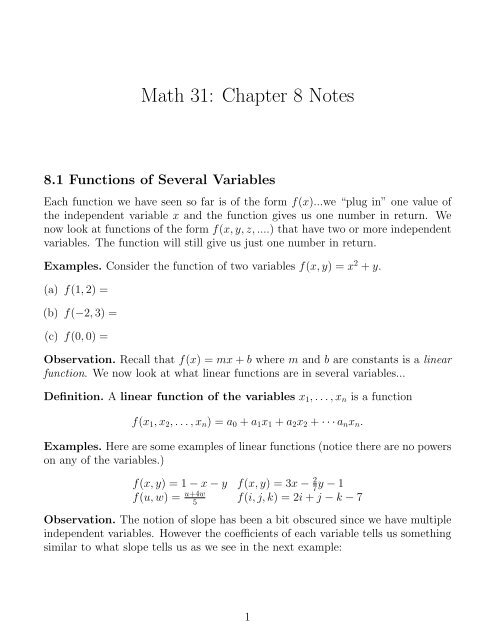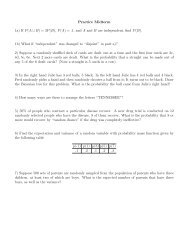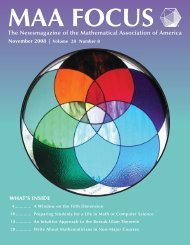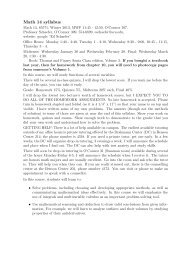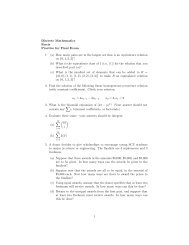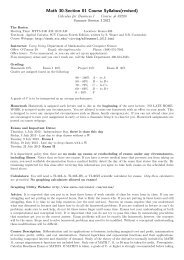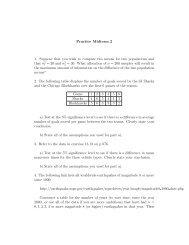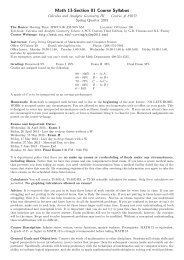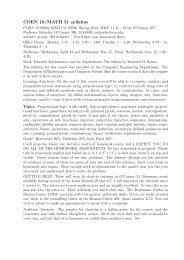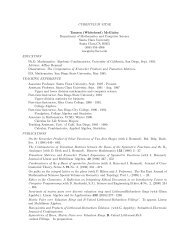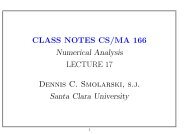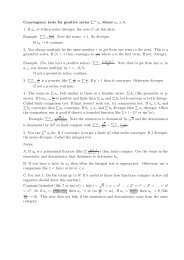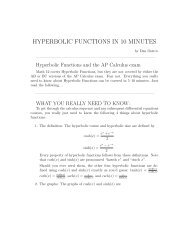Math 31: Chapter 8 Notes
Math 31: Chapter 8 Notes
Math 31: Chapter 8 Notes
Create successful ePaper yourself
Turn your PDF publications into a flip-book with our unique Google optimized e-Paper software.
<strong>Math</strong> <strong>31</strong>: <strong>Chapter</strong> 8 <strong>Notes</strong><br />
8.1 Functions of Several Variables<br />
Each function we have seen so far is of the form f(x)...we “plug in” one value of<br />
the independent variable x and the function gives us one number in return. We<br />
now look at functions of the form f(x, y, z, ....) that have two or more independent<br />
variables. The function will still give us just one number in return.<br />
Examples. Consider the function of two variables f(x, y) = x 2 + y.<br />
(a) f(1, 2) =<br />
(b) f(−2, 3) =<br />
(c) f(0, 0) =<br />
Observation. Recall that f(x) = mx + b where m and b are constants is a linear<br />
function. We now look at what linear functions are in several variables...<br />
Definition. A linear function of the variables x 1 , . . . , x n is a function<br />
f(x 1 , x 2 , . . . , x n ) = a 0 + a 1 x 1 + a 2 x 2 + · · · a n x n .<br />
Examples. Here are some examples of linear functions (notice there are no powers<br />
on any of the variables.)<br />
f(x, y) = 1 − x − y f(x, y) = 3x − 2 7 y − 1<br />
f(u, w) = u+4w<br />
5<br />
f(i, j, k) = 2i + j − k − 7<br />
Observation. The notion of slope has been a bit obscured since we have multiple<br />
independent variables. However the coefficients of each variable tells us something<br />
similar to what slope tells us as we see in the next example:<br />
1
Example. Let f(x, y) = 2 + 6x − 9y.<br />
Example. Suppose the daily fixed cost for manufacturing cars and trucks at a plant<br />
is $100 thousand . It costs $8 thousand to produce each truck and $6 thousand for<br />
each car. Find the linear daily cost function C(x, y) for this plant.<br />
Definition. If we add to a linear function a term of the form bx i x j with b ≠ 0 and<br />
i ≠ j we get a second-order interaction equation.<br />
Class Exercise. ($8.1 #12)<br />
Example. The table gives the values of a function f(x, y).<br />
(a) Find f(0, 1)<br />
(b) f(2, 3) =<br />
(c) Is f linear?<br />
(d) Find an equation for f(x, y).<br />
Class Exercise. (#8)<br />
0 1 2 3<br />
0 -1 0 1 2<br />
1 3 4 5 6<br />
2 7 8 9 10<br />
3 11 12 13 14<br />
2
8.2 Three-Dimensional Space and Graphs of Functions of<br />
Two Variables<br />
Graphs of functions of two variables f(x, y) lie in three-dimensional space (3-<br />
space).<br />
Plotting points in 3-space:<br />
The familiar xy-plane has two axes, the x-axis and the y-axis. To form 3-space we<br />
form another axis called the z-axis. A point in 3-space is specified by (x, y, z) and<br />
we get to this point by going x units along the x-axis, y units along the y-axis, and<br />
z units along the z-axis.<br />
Example. Plot the points (1, 2, 3) and (−1, −2, 1).<br />
Definition. The graph of a function of two variables z = f(x, y) is the set of<br />
all points (x, y, f(x, y)) in 3-space. ( Of course, (x, y) must lie in the domain of f.)<br />
Such a graph is often called a surface.<br />
Example.<br />
(a) Sketch the graph of z = 0 and z = 1 in 3-space.<br />
(b) Sketch the graph of x = 0 and x = 1 in 3-space.<br />
3
Example. Sketch the graph of the function z = f(x, y) = x 2 + y 2 .<br />
Definition. If we have a surface z = f(x, y), and we fix a value for z, say z = c,<br />
the set of all points satisfying c = f(x, y) is a level curve of the surface.<br />
Graphs of Linear Functions: Planes The graphs of all linear functions are<br />
planes. Looking at the graphs of z = 0 and z = 1 we get a clear picture of what<br />
planes look like. For a general linear function the plane will be at some angle.<br />
Example. Sketch z = f(x, y) = 1 − x − y.<br />
(a) x-intercept (set y = z = 0):<br />
(b) y-intercept (set x = z = 0):<br />
(c) z-intercept (set x = y = 0):<br />
Three points are enough to determine a plane. We can form a triangle from these<br />
3 points. The plane of this triangle is the graph of f.<br />
Alpha demonstration:<br />
Class Exercise. ($8.2 #11-18)<br />
4
8.3 Partial Derivatives<br />
Recall. df<br />
dx<br />
is the derivative of f with respect to x. It tells us how fast is f changing<br />
as x changes.<br />
Definition. Let f(x, y, . . . ) be a function of several variables. The partial derivative<br />
of f with respect to x is the derivative we get when we differentiate<br />
f(x, y, . . . ) with respect to x while treating all other variables as constants. The<br />
partial derivative of f with respect to x is denoted by ∂f<br />
∂x<br />
partial derivatives with respect to other variable, ∂f<br />
∂y , ∂f<br />
. We can similarly define<br />
∂z , etc.<br />
Notation.<br />
• The symbol ∂f ∣<br />
∂x (a,b)<br />
means we evaluate the function ∂f<br />
∂x<br />
at the point (a, b).<br />
• ∂f<br />
∂x<br />
and<br />
∂f<br />
∂y are also denoted by f x and f y .<br />
Examples. Let f(x, y) = x 2 − 4xy.<br />
(a) ∂f<br />
∂x =<br />
(b) ∂f ∣<br />
(1,1)<br />
=<br />
∂x<br />
(c) ∂f<br />
∂y =<br />
(d) If C(x, y) is a cost function, ∂C<br />
∂x<br />
and<br />
∂C<br />
∂y<br />
are the marginal cost functions.<br />
Class Exercise. ($8.3 #46) Interpret your answer.<br />
Interpretation of Partial Derivatives and Marginal Costs:<br />
The partial derivative ∂C ∣<br />
∂x (a,b)<br />
is the approx. cost of the (a + 1) st “x” item, and<br />
∣<br />
(a,b)<br />
is the approx. cost of the (b + 1) st “y” item.<br />
∂C<br />
∂y<br />
5
Geometric Interpretation of Partial Derivatives:<br />
∂f ∣<br />
∂x (a,b)<br />
is the slope of the tangent line to the surface z = f(x, y) in the vertical<br />
plane y = b, and ∂f ∣<br />
∂y (a,b)<br />
is the slope of the tangent line to the surface z = f(x, y)<br />
in the vertical plane x = a.<br />
Second-Order Partial Derivatives: These will be helpful when we study how<br />
to maximize and minimize functions of two variables.<br />
• f xx = (f x ) x = ∂2 f<br />
∂x 2<br />
= ∂<br />
∂x (∂f ∂x )<br />
• f yy = (f y ) y = ∂2 f<br />
∂y 2<br />
= ∂ ∂y (∂f ∂y )<br />
• f xy = (f x ) y = ∂2 f<br />
∂y∂x = ∂ ∂y (∂f ∂x )<br />
• f yx = (f y ) x = ∂2 f<br />
∂x∂y = ∂<br />
∂x (∂f ∂y )<br />
Fact. Amazingly, we always have f xy = f yx !<br />
Class Exercises. As you compute these, verify that f xy = f yx .<br />
(a) ($8.3 #24)<br />
(b) ($8.3 #26)<br />
6
8.4 Maxima and Minima (2 Lectures )<br />
Day 1 : Types of Max/Min and Critical Points<br />
Definition. Let f(x, y, . . . ) be a function of several variables.<br />
• f has a relative maximum at the point (r, s, . . . ) if the value f(r, s, . . . ) is<br />
bigger than all other values in the immediate vicinity.<br />
• f has a relative minimum at the point (r, s, . . . ) if the value f(r, s, . . . ) is<br />
smaller than all other values in the immediate vicinity.<br />
• f has a absolute maximum at the point (r, s, . . . ) if the value f(r, s, . . . )<br />
is the largest value of the function over its entire domain.<br />
• f has a absolute minimum at the point (r, s, . . . ) if the value f(r, s, . . . ) is<br />
the smallest value of the function over its entire domain.<br />
Definition. Relative maxima and relative minima are called the relative extrema<br />
of f<br />
Observation. Absolute maxima and absolute minima are special kinds of relative<br />
extrema.<br />
All the above definitions have analogous notions in the single variable case. The<br />
next notion is not analogous to anything in the single variable case:<br />
Definition. Let f(x, y) be a function of two variables. f has a saddle point at<br />
(r, s) if f has a relative maximum along some slice through the point, and a relative<br />
minimum along some other slice through the point.<br />
Candidates for Extrema: Critical Points<br />
Definition. Points in the domain of f where all partial derivatives are zero are<br />
critical points of f.<br />
Fact. Critical points of f are the only candidates for relative extrema and saddle<br />
points of f in the interior of the domain of f.<br />
7
Warning. A critical point is not necessarily an extrema or saddle point! Further<br />
checks are needed to determine whether it is or not.<br />
Next lecture we will learn a test to determine if a critical point gives an extrema<br />
or not.<br />
Example. ($8.4 #14) Find all critical points of the function g(x, y) = x 2 + x +<br />
y 2 − y − 1.<br />
Class Exercise. ($8.4 #28) Find all critical points of the function g(x, y) = x 3 +<br />
y 3 + 3<br />
xy . 8
8.4 Maxima and Minima - Day 2<br />
GOAL: Classify Critical Points<br />
Definition. Let f be a function of two variables and (a, b) be a critical point. The<br />
quantity<br />
H = H(a, b) = f xx (a, b)f yy (a, b) − [f xy (a, b)] 2<br />
is called the Hessian at the point (a, b).<br />
Fact. (Second Derivative Test) Let f be a function of two variables and (a, b)<br />
be a critical point.<br />
1. If H(a, b) > 0, then,<br />
• f has a relative min at (a, b) if f xx (a, b) > 0<br />
• f has a relative max at (a, b) if f xx (a, b) < 0,<br />
2. If H(a, b) < 0,<br />
• f has a saddle point at (a, b).<br />
3. If H(a, b) = 0,<br />
• The test is inconclusive. A table or graph can be used to decide what<br />
kind of extrema exist at (a, b).<br />
Example. ($8.4 #12) Find and classify all the critical points of f(x, y) = 4−(x 2 +<br />
y 2 ).<br />
9
Class Exercise. ($8.4 #20) Find and classify all the critical points of t(x, y) =<br />
x 3 − 3xy + y 3 .<br />
Example. Find and classify all the critical points of f(x, y) = y 2 .<br />
Example. Find and classify all the critical points of f(x, y) = x 3 .<br />
10
8.5 Constrained Maxima and Minima<br />
We have seen how to find extrema of functions over their entire domains.<br />
GOAL: Find Max and Mins of a function f subject to constraints (over<br />
restricted domain)<br />
Example. If you want to make a closed box with square bases that holds 125 cm 3 ,<br />
what box dimensions produce a box requiring the least material?<br />
Example. Find the maximum value of the function f(x, y, z) = 4 − (x 2 + y 2 + z 2 )<br />
subject to the constraint (a) z = 2x and (b) z = 1.<br />
Idea: Solve the constraint for one of the variables and substitute. Then<br />
maximize the resulting function of two variables.<br />
Example. If you want to make an open-top rectangular box that will hold 4 cm 3 ,<br />
what box dimensions produce a box requiring the least material?<br />
Class Exercise. ($8.5 #6)<br />
11
Example. ($5.2 #20)<br />
Preview of Next Lecture: Sometimes it is too hard or impossible to eliminate<br />
one of the variables. For example, imagine if the constraint equation was x 2 +y 2 = 1<br />
or (zxy) 3 = x 7 + y 8 − z 9 . In such cases we can use the method of Lagrange Multipliers.<br />
We will discuss this method next lecture. Even if it is possible to solve<br />
for one of the variables, Lagrange multipliers always provides an alternative way<br />
to find extrema and can sometimes be quicker.<br />
Distance functions: The distance between two point P (x 1 , y 1 ) and Q(x 2 , y 2 ) in<br />
the xy−plane is<br />
d = √ (x 2 − x 1 ) 2 + (y 2 − y 1 ) 2<br />
.<br />
For two points in 3-space P (x 1 , y 1 , z 1 ) and Q(x 2 , y 2 , z 2 ) the distance between<br />
them is<br />
d = √ (x 2 − x 1 ) 2 + (y 2 − y 1 ) 2 + (z 2 − z 1 ) 2<br />
.<br />
Example. Find the distance between the points (3, −2) and (−1, 1).<br />
Example. Find the distance between the points (1, 1, 1) and (−1, 1, 2).<br />
Fact. The equation for a circle of radius r with center at the origin is<br />
x 2 + y 2 = r 2 .<br />
Question. What geometric shape in 3-space is given by the solutions to the equation<br />
x 2 + y 2 + z 2 = r 2 ?<br />
12
Constrained Maxima and Minima - Day 2<br />
Lagrange Multipliers<br />
Fact. Locating Relative Extrema with Lagrange Multipliers<br />
The candidates for relative extrema of f(x, y, . . . ) subject to the constraint g(x, y, . . . ) =<br />
0 are the solutions to equations<br />
f x = λg x<br />
f y = λg y<br />
· · ·<br />
g = 0<br />
The constant λ is called a Lagrange multiplier.<br />
Observation. The value of the Lagrange multiplier λ does not matter; hence, it<br />
is usually a good idea to try to eliminate it from the system of equations as early<br />
as possible.<br />
Example. Maximize f(x, y) = xy subject to the constraint x 2 + y 2 = 2.<br />
Warning. If we assume extrema exist there is no problem with just evaluating at<br />
critical points and comparing, but be aware that we are making an assumption<br />
here.<br />
Class Exercise. ($8.5 #12) Minimize f(x, y) = x 2 + y 2 subject to constraint<br />
xy 2 = 16.<br />
13
Example. ($8.5 #22)<br />
Example. ($8.5 #28) Find point on plane 2x − 2y − z + 1 = 0 closest to (1, 1, 0).<br />
14


